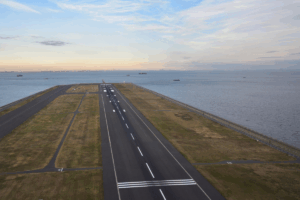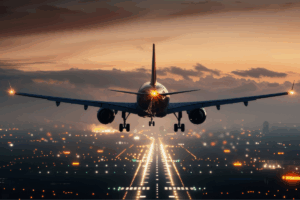跑道照明系统旨在减少飞行员的不确定性。它们引导飞机通过低能见度条件,防止跑道入侵,并确保安全、高效的起飞、着陆和地面移动
任何完整的跑道照明系统的关键组成部分都是照明风锥。这些高科技装置为飞行员在进场、着陆和滑行时提供可靠、实时的地面风向和相对风速信息。如果没有它们,就有可能发生逆风着陆、起飞失败和跑道事故。
跑道风锥如何工作?
风筒(也称风袜)是一种相对简单的技术,由一个安装在带旋转装置的杆子上的织物圆锥体组成。旋转装置可以让风筒自由转动,并与风向保持一致。例如,如果风筒朝南,说明风是从北面吹来的。
美国联邦航空局 AC 150/5345-27 规定风筒可以是白色、黄色或橙色,颜色的选择通常因地区而异。例如,美国机场通常使用橙色,而澳大利亚通常使用白色。有些机场使用双色风筒,如红色和白色,第一、中间和最后一条的颜色较深。
风筒还通过不同程度的充气为飞行员提供风速指示。许多风筒分为五段,每段代表约 3 节(3.5 英里/小时或 5.5 公里/小时)的风速。这意味着,如果充气三段,风速可估算为 9 节(10.5 英里/小时或 16.5 公里/小时)。完全伸展的风锥通常表示风速为 15 节(17 英里/小时或 28 公里/小时)或以上。
通常情况下,机场会在跑道中点附近的分段圆圈内或附近安装至少一个主风锥。许多机场还在每条跑道的末端安装额外的风锥。
风向标的一个独特之处在于,与系统的其他部分不同,风向标的运行不依赖于数字读数、数据传输或软件。它们能够提供不受通信延迟影响的即时参考点,这也是美国联邦航空局(FAA)和国际民航组织(ICAO)标准规定在各种规模的机场都必须配备风向标的原因。
在夜间作业、恶劣天气和其他低能见度条件下使用带灯风筒
风锥与跑道照明系统的其他部分一样,只有在可见的情况下才能发挥有效作用。因此,这些装置需要内部或外部照明,以确保持续可见性。
外部风筒灯
该系统由从地面射向风锥的泛光灯或其他光源组成。地面灯具的位置必须尽量减少眩光,以免分散飞行员的注意力或使其失明。风筒水平面的照明度至少要达到 2 英尺烛光 (fc),以确保风筒上表面在整个旋转过程中保持良好的照明。
内部风筒灯
这些灯位于风筒内,使风筒发光,以提高弱光条件下的能见度。内部照明的风筒必须与备用或冗余光源连接,以确保在光源出现故障时能持续照明。它们必须保持 10 至 30 英尺伦比(fL)的平均亮度,任何一点的最低亮度不得低于 2 英尺伦比。
拥有先进照明控制和监控系统(ALCMS)的机场可以将风筒照明集成到跑道和滑行道照明使用的同一监控网络中。许多风锥还具有可调节的亮度设置,以适应雾、雨或其他低能见度条件下对不同照明度的要求。
与许多其他跑道灯一样,大多数机场正在从白炽灯或卤素灯转向发光二极管(LED)技术。LED 比以前的灯泡更节能、寿命更长,有助于机场运营商降低灯泡维护、更换和能源成本。LED 照明风筒还能更好地抵御机场使用过程中的振动和温度波动。
阅读更多 保护跑道照明免受极端天气影响的技巧
延长风筒的使用寿命
风锥会受到各种恶劣环境条件的影响,如狂风、积冰、风沙侵蚀、紫外线照射等。如果风筒织物褪色、撕裂或积冰,其提供准确可靠信息的能力就会受到影响。同样,照明组件也必须经受住持续暴露而不被腐蚀或短路。
在调试新风筒或升级现有风筒时,应选择具有以下特点的设备:
- 高强度、抗紫外线织物,经年风吹日晒、温度变化和环境暴露,仍能抗撕裂并保持可视性
- 密封的电气外壳和垫圈可防止湿气进入灯具
- 阳极氧化或粉末涂层的安装硬件可防腐蚀
风筒安装完毕后,需要对其进行例行检查,以防出现问题,进而演变成严重问题。例如,检查安装杆是否有腐蚀、电线是否有损坏、灯泡是否有问题。织物也不应有任何问题,如撕裂、褪色或其他损坏。
如果您对风筒有任何疑问,请联系 Airport Lighting Company 的专家。我们非常乐意为客户量身定制解决方案,以提高他们的运营水平。
阅读更多 我们的产品
请致电 Airport Lighting Company,了解最新的机场照明技术
Airport Lighting Company 团队是 随时准备回答您的问题 了解我们的技术产品如何帮助您提高跑道的安全性、可靠性和效率。请致电 315-682-6460,我们将为您提供快速、友好的服务。


